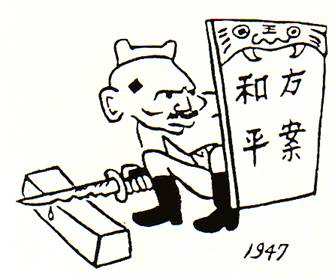The Chinese Civil War
By the end of 1945 the Nationalists moved back to Nanjing confident of a successful future because of their many advantages over the Communists.
The Nationalists:
- had international recognition as the legal government of China, and held a permanent seat on the Security Council of the United Nations
- had the support from the United States of America, a post-war superpower
- had an air force and an army of nearly three million
- had a well-recognised leader who had once made front page of Time magazine.
The Communists:
- were not recognised as an important political force in China
- were not trusted by the Americans
- were not trusted by the Russian communists
- possessed an army estimated to be around one million.
By 1949, however, a complex interplay of divisive forces including ideology, army morale, leadership and national acceptance had destroyed the basis of Nationalist power.
During the Chinese Civil War the Nationalists lost further support from the Chinese people. By 1949 intellectuals, nationalists, peasants, the middle class and industrialists finally rejected Jiang Jieshi's government.
Open this link to learn more about the main stages of the Civil War.
The short term reasons for Communist victory in 1949 are evident in the study of the Chinese Civil War.
July 1946 to June 1947
- Jiang refused to accept the USA mediation with the Communists and conflict between the two began in July.
- There were Nationalist military successes in Manchuria and Yan'an.
- The Nationalists initiated political reform.
July 1947 to April 1949
- The Communists held the countryside (PLA militia) and cut supplies to the cities occupied by the Guomindang.
- The PLA offensive captured Central China.
- During the Battle of Huai Hai 200 000 Nationalists died and 300 000 were imprisoned or deserted.
- Beijing was captured by the PLA in January 1949 and Nanjing taken by Zhu De's forces in April 1949.
- Jiang Jieshi retired as leader of the Nationalist government and was replaced by Li Zongren.
April 1949 to December 1949
- In April Nanjing fell to the Communists, followed by Shanghai in May and Guangzhou in October.
- On 1 October the Chinese Communist Party declared victory and announced the People's Republic of China.
- Chongqing was captured in December 1949.
- Jiang and the Nationalist government fled to Formosa (now referred to as Taiwan).
 Open this link and complete the questions The Chinese Civil War
Open this link and complete the questions The Chinese Civil War  .
.
 Click on the 'open' button below to access the activity.
Click on the 'open' button below to access the activity.
Anti-Nationalist cartoon 1947
The anti-Nationalist cartoon below shows a stressed Jiang Jieshi holding a well-worn knife. He is hiding behind a shield promising a peace plan. He has a plaster on his head symbolising a high level of stress.
 Cartoon entitled 'I will kill after sharpening |
This cartoon was created by Hua, an anti-Nationalist cartoonist whose work was published by the Communists in the Yan'an area. He was blacklisted by the Nationalists, his work censored and he was branded a traitor. This cartoon provides an example of Communist propaganda during the Chinese Civil War. The caption for this cartoon reads 'I will kill after sharpening the knife'. |
1 |





